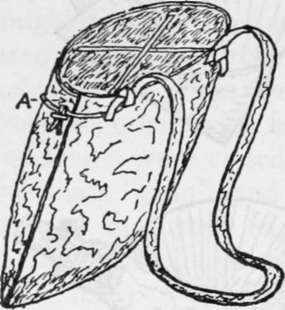Bast Ropes And Twine
Description
This section is from the book "Camping And Woodcraft", by Horace Kephart. Also available from Amazon: Camping and Woodcraft.
Bast Ropes And Twine
Straps, %h-stringers, ?tc. are made from the whole bark of pawpaw. leatherwood (remarkably strong), and hickory shoots. Very good ropes and twine can be made from the fibers of the inner bark of the slippery, white, and winged elms, the pignut and other hickories, white oak, and buckeye, red cedar, yellow locust, red mulberry, and Osage-orange. One who has not examined the finished work would scarce believe what strong, soft, and durable cordage, matting, braided tump-lines, and even thread, fish-nets, and garments can be made from such materials by proper manipulation. The Indians first separate the bark in long strips, remove the woody outer layer, and then boil it in a lye of sifted wood ashes and water, which softens the fiber so it can be manipulated without breaking. After it is dried it can be separated into small filaments by pounding, the strings running with the grain for several feet. Slippery elm especially makes a pliable rope, soft to the touch; it can be closely braided, and is very durable. If the woody splinters and hard fragments have not been entirely removed by pounding, the shoulder blade of a deer is fastened to an upright post, an inch hole is drilled through it, and bunches of the boiled bark are pulled backward and forward through the hole. The filaments are then put up in hanks and hung aside for use, being boiled to supple them when needed.

Fig. 96. Fish bucket.
Bark twine is made by holding in the left hand one end of the fiber as it is pulled from the hank, and separating it into two parts, which are laid across the thigh. The palm of the right hand is then rolled forward over both, so as to twist tightly the pair of strands, when they are permitted to unite and twist into a cord, the Aeft hand drawing it away as completed. Other strands are twisted in to make the length of cord desired. Twine and thread are made from the bark of young sprouts.
The bast or inner rind of basswood (linden) makes good rope. More than a century ago, two Indians whose canoe had drifted, while they were in a drunken sleep, upon Goat Island, between the American and Canadian falls of Niagara, let themselves down over the face of the cliff by a rope that they made from basswood bark, and thus escaped from what seemed to the on-lookers as certain death by starvation.
Mulberry and Osage orange bast yield a fine, white, flax-like fiber, that used to be spun by squaws to the thickness of packthread and then woven into garments. The inner bark of Indian hemp (Apocynum cannabinum), collected in the fall, is soft silky, and exceedingly strong. The woody stems are first soaked in water; then the bast, with bark adhering, is easily removed; after which the bark is washed off, leaving the yellowish-brown fiber ready to be picked apart and used. A rope made from it is stronger, and keeps longer in water, than one made from common hemp. It was formerly used by the Indians, almost all over the continent, not only for ropes, but for nets, threads, and garments. The fibers of the nettle were also similarly used.
In the southern Appalachians, it is not many-years since the mountain women used to make bedcords (perhaps you know how strong such cords must be) by twisting or plaiting together long, slender splits of hickory wood (preferably mocker-nut) that they suppled by soaking. Such bed-cords are in use to this day.
Continue to:
